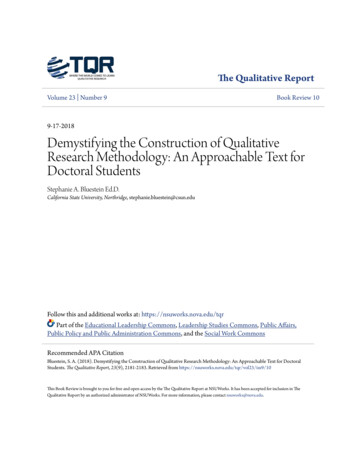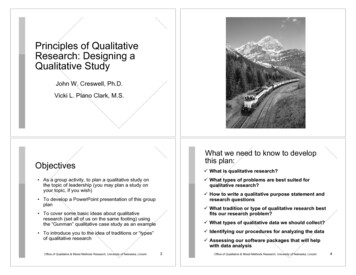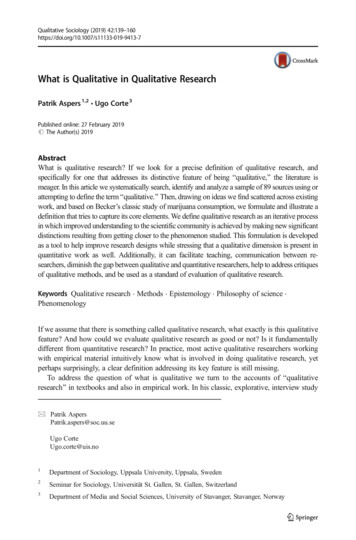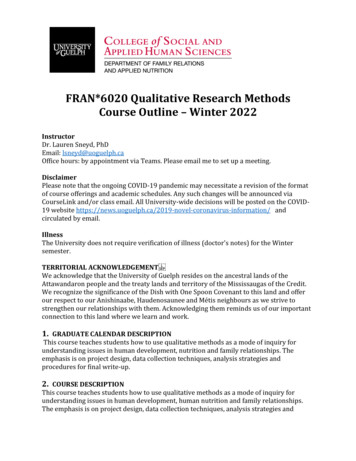
Transcription
The Qualitative ReportVolume 23 Number 9Book Review 109-17-2018Demystifying the Construction of QualitativeResearch Methodology: An Approachable Text forDoctoral StudentsStephanie A. Bluestein Ed.D.California State University, Northridge, stephanie.bluestein@csun.eduFollow this and additional works at: https://nsuworks.nova.edu/tqrPart of the Educational Leadership Commons, Leadership Studies Commons, Public Affairs,Public Policy and Public Administration Commons, and the Social Work CommonsRecommended APA CitationBluestein, S. A. (2018). Demystifying the Construction of Qualitative Research Methodology: An Approachable Text for DoctoralStudents. The Qualitative Report, 23(9), 2181-2183. Retrieved from https://nsuworks.nova.edu/tqr/vol23/iss9/10This Book Review is brought to you for free and open access by the The Qualitative Report at NSUWorks. It has been accepted for inclusion in TheQualitative Report by an authorized administrator of NSUWorks. For more information, please contact nsuworks@nova.edu.
Demystifying the Construction of Qualitative Research Methodology: AnApproachable Text for Doctoral StudentsAbstractDurdella’s text, Qualitative Dissertation Methodology: A Guide for Research Design and Methods, breaks downthe steps for conducting qualitative research in applied programs of study and social behavioral science fields.The book, also useful to department chairs and program directors, focuses on designing a qualitative study,conducting the study and analyzing the data. Useful advice drawn from Durdella’s experience as a dissertationcommittee chair, in addition to introspective questions for the student, help to demystify the methodologychapter and, thus, could have a positive impact on programs.KeywordsQualitative Research, Methodology Chapter, Dissertation Writing, Applied Fields of Study, Social BehavioralScience Fields of StudyCreative Commons LicenseThis work is licensed under a Creative Commons Attribution-Noncommercial-Share Alike 4.0 License.This book review is available in The Qualitative Report: https://nsuworks.nova.edu/tqr/vol23/iss9/10
The Qualitative Report 2018 Volume 23, Number 9, Book Review 2, 2181-2183Demystifying the Construction of a Qualitative ResearchMethodology: An Approachable Text for Doctoral StudentsStephanie A. BluesteinCalifornia State University, Northridge, USADurdella’s text, Qualitative Dissertation Methodology: A Guide for ResearchDesign and Methods (2019), breaks down the steps for conducting qualitativeresearch in applied programs of study and social behavioral science fields. Thebook, also useful to department chairs and program directors, focuses ondesigning a qualitative study, conducting the study and analyzing the data.Useful advice drawn from Durdella’s experience as a dissertation committeechair, in addition to introspective questions for the student, help to demystifythe methodology chapter and, thus, could have a positive impact on programs.Keywords: Qualitative Research, Methodology Chapter, Dissertation Writing,Applied Fields of Study, Social Behavioral Science Fields of StudyDoctoral students start off motivated and eager, albeit nervous, having decided to investsignificant time and money to fulfill their dream of obtaining the academy’s highest degree.But fast forward several years and students usually have fallen into one of two categories: thoseon track to defend their dissertation and those who are sadly realizing they may never reachthat magnificent day.Higher education institutions welcome students into their doctoral programs who aredeemed worthy of the academic challenge. So then why do roughly half of those admitted neverfinish their degree and, more importantly, what can be done to help fix this complex problem?A newly released textbook has the potential to make a significant difference in thenumber of students who end up with a Ph.D. or Ed.D., as opposed to being ABD. In QualitativeDissertation Methodology: A Guide for Research Design and Methods, Nathan Durdella offersa comprehensive manual for conducting qualitative research in applied programs of study andsocial behavioral science fields. The text contains erudite advice for every step of the journey,from choosing a dissertation chair, to deciding the most appropriate research tradition for theproposed study, to conducting the field work and, lastly, to picking an interpretive paradigm toanalyze the data.Serving as dissertation committee chair for many students (including myself) in theEducational Leadership and Policy Studies doctoral program at California State University,Northridge, Durdella picked up on patterns that threaten to derail dissertation completion. Hepoints out students often are trying to decide the topic and focus of their dissertation eventbefore they have even learned about methods, academic writing and research design. “Thisprocess—marked by intense emotional dynamics, intellectual engagement and often physicaland mental demands—tends to strain students who sometimes balance work activities andprofessional obligations (not to mention family commitments) with academic courserequirements and the demands of dissertation writing” (2019, p. xvii). Thus, students can feeloverwhelmed and underprepared from the very first semester, potentially undermining theirability to finish their dissertation and earn their degree.Durdella spent a sabbatical semester tackling this decades-old problem, resulting in atext that is truly a gift to both students and their department chairs and program directors.Rightly so, it takes a deep dive into the methodology chapter—truly the heart of thedissertation—because the strength of any dissertation study lies in how well the study is
2182The Qualitative Report 2018planned and executed. This is a different approach from competing textbooks, which tend tocover the entire qualitative dissertation, as Durdella accurately points out in the preface. Histext is divided into three parts to cover these crucial topics: establishing one’s dissertationcommittee, developing the original study and analyzing the data. Each of the 10 chapters beginswith a short explanation of its purpose and learning objectives and includes pertinent questionsstudents should ask of themselves, such as, “What physical or virtual sites or research settingscould serve as backups in case I ultimately cannot access participants in my current oranticipated site(s) or setting(s)?”A variety of helpful charts—including a three-year timeline for completion—providevaluable information. In addition, Durdella cites examples from his students’ work, such asexactly how study participants were described in the dissertation and some of the questionsthey were asked. To supplement the text, Durdella (2018a) recorded a 13-minute video titled“Developing Skills in Formulating Qualitative Research Questions” and a 15-minute videocalled “Key Skills in Writing a Qualitative Research Proposal” (Durdella, 2018b), which helpbring a human touch to topics students may otherwise view as a bit dry.He also recounts some experiences he’s had as a committee chair, as well as a facultymember who vigorously defends qualitative research methods. One poignant story recounts theday he received an email from a student who was frustrated because her committee chair castdoubt on the design of her qualitative study, suggesting she also needed a survey. “I advisedher to argue that there are multiple approaches to ensure quality in qualitative research—thatshe did not need to ‘tack on’ a survey to enhance her findings and recommendations at the endof her study,” wrote Durdella (2019, p. 89). Durdella’s warmth in the classroom comes throughin the text, which uses plenty of first- and second-person references. It’s an approachable andquite readable text, especially for re-entry students, and would be ideal for both on-ground andonline classes. He has an exceptional way of empowering his students, which is evidenced inthis writing about the student’s role as researcher:Beyond the normative practices and attitudes about research in disciplinary andresearch communities, you control a lot of what happens in your study. Frombeginning to end, conceptualization to implementation, you are the chiefresearch instrument in your dissertation study. Throughout this book, the ideathat you are at the center of your study has been consistent, and the componentsof your dissertation methodology chapter reveal who you are as a researcher.(2019, p. 296)The beauty of this text is it demystifies the process of constructing a qualitative dissertationmethodology. This is the big hurdle a student must cross to make it to degree completion. Whileit could have used more specifics on how to get dissertation findings accepted at a conferenceand published in a peer-reviewed journal, overall the text is a solid all-in-one qualitativeresearch manual for students in applied and social behavioral science fields. And with morepressure being put on institutions to increase their graduation rates, this text could very wellhelp more students earn their doctorate degrees.ReferencesDurdella, N. (2018a). Developing skills in formulating qualitative research questions. ing-qualitativeresearch-questionsDurdella, N. (2018b). Key skills in writing a qualitative research proposal. SAGE Research
Stephanie A. Bluestein2183Methods Video. Available from ing-a-qualitative-research-proposalDurdella, N. (2019). Qualitative dissertation methodology: A guide for research design andmethods. Thousand Oaks, CA: Sage Publications.Author NoteStephanie A. Bluestein, Ed.D., is an associate professor of journalism at California StateUniversity, Northridge. Correspondence regarding this article can be addressed directly to:Stephanie.Bluestein@csun.edu.Copyright 2018: Stephanie A. Bluestein and Nova Southeastern University.Article CitationBluestein, S. A. (2018). Demystifying the construction of qualitative research methodology:An approachable text for doctoral students. The Qualitative Report, 23(9), 2181-2183.Retrieved from https://nsuworks.nova.edu/tqr/vol23/iss9/10
Demystifying the Construction of Qualitative Research Methodology: An Approachable Text for Doctoral Students Abstract Durdella's text,Qualitative Dissertation Methodology: A Guide for Research Design and Methods, breaks down the steps for conducting qualitative research in applied programs of study and social behavioral science fields.










